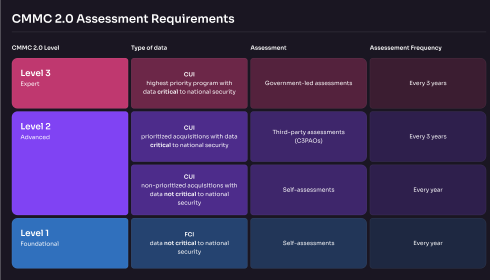Do Basic Assessments Cover All CMMC Level 1 Requirements in Practice

Business leaders often assume that a basic self-assessment is enough to meet compliance expectations. In reality, what looks sufficient on paper may not stand firm once auditors review the details. The question remains: do these assessments fully address CMMC level 1 requirements, or do they leave behind weak spots that demand closer attention?
Do Basic Assessments Miss Certain Baseline Controls
Basic assessments often provide a surface-level review of security practices but may not capture every baseline control. While they touch on key elements such as access control or password protections, they frequently lack the depth needed to prove compliance under real conditions. CMMC compliance requirements emphasize that practices must not only exist but also function consistently.
An internal checklist might confirm that multi-factor authentication is in place, yet it may not measure whether the technology is implemented across all endpoints. For contractors aiming to align with CMMC level 1 requirements, these gaps create risks during audits. Without addressing them, the organization may fall short of what a C3PAO would validate in an official review.
Recognizing Gaps That Simple Reviews Often Overlook
Simple reviews are designed for efficiency, but efficiency can come at the cost of thoroughness. For instance, many teams fail to record evidence of how access permissions are monitored, or whether removable media use is controlled. These overlooked elements directly tie back to the 17 CMMC level 1 requirements, and missing documentation weakens compliance claims.
In practice, gaps also appear when policies are written but not enforced. A basic assessment might mark a requirement as “met” without verifying the process behind it. This is where a CMMC RPO can help identify gaps that internal staff might overlook. Recognizing and correcting these issues before a formal audit protects against delays and failed attempts at CMMC level 2 compliance down the road.
How Basic Assessments Align with the 17 Level 1 Practices
CMMC level 1 requirements center on safeguarding Federal Contract Information through 17 core practices. A basic assessment can align with these practices if it systematically checks that each one is addressed. The effectiveness of such an assessment depends on whether the review includes evidence collection, not just verbal confirmations or unchecked boxes.
Alignment means proving that processes like user identification, incident reporting, and limited access to physical systems are functioning as intended. A CMMC RPO can guide teams in ensuring their assessments mirror what a C3PAO will eventually test. Done correctly, a basic review becomes a practical roadmap toward both compliance and security improvement.
Why Self-evaluations May Fail Under Real Audit Scrutiny
Self-evaluations often fall short because they lack the impartiality and rigor expected in a formal audit. An internal team may assume compliance based on policies, yet a C3PAO audit demands evidence of consistent practice. Without that evidence, even organizations meeting CMMC level 1 requirements may fail to demonstrate them convincingly.
Audit scrutiny also focuses on whether practices are embedded into daily operations. A checklist noting password rotations is not enough unless logs confirm that those rotations occur regularly. This gap becomes more visible in transitions to CMMC level 2 compliance, where controls demand even stronger validation.
When Basic Assessments Deliver Sufficient Compliance Evidence
Not all basic assessments lack value. When conducted with discipline, they can provide sufficient compliance evidence for CMMC level 1 requirements. The key lies in whether the review includes documented proof, such as access control reports, policy acknowledgments, and system configurations.
Organizations that document these elements thoroughly are better positioned for audits. If a basic assessment mirrors the scope and rigor of a third-party review, it can satisfy compliance demands. However, this requires a clear understanding of CMMC compliance requirements and consistency in recording evidence.
Identifying Weak Spots That Require Deeper Inspection
Weak spots appear in areas that basic assessments rarely probe. These often include incident response readiness, proper sanitization of media, and system monitoring. While listed within CMMC level 1 requirements, they are easy to overlook in a quick review process.
Deeper inspection by a CMMC RPO or preparation for a C3PAO audit ensures these blind spots do not undermine compliance. Identifying them early prevents last-minute fixes, which often cost more and create unnecessary stress. For contractors seeking CMMC level 2 requirements in the future, addressing weak spots at level 1 creates a stronger foundation.
Validating That Basic Reviews Satisfy FAR 52.204-21 Demands
FAR 52.204-21 outlines the basic safeguarding of contractor information systems, which directly aligns with CMMC level 1 requirements. A basic assessment must validate that the 15 security requirements under FAR are also addressed. If the review leaves out technical verification, it may not fully satisfy government expectations.
Validation requires more than yes-or-no responses. Evidence such as system logs, configuration screenshots, and employee training records must support each claim. By ensuring this alignment, organizations demonstrate they understand the full scope of compliance rather than offering surface-level answers.
Comparing Self-assessment Outcomes Against Third Party Scrutiny
The difference between self-assessment outcomes and third-party scrutiny often lies in the level of detail. Self-reviews may indicate compliance based on intent, while C3PAO auditors require proof of execution. This difference explains why many organizations feel confident internally yet stumble under official audits.
Comparing both outcomes reveals areas where internal teams overestimate readiness. Engaging a CMMC RPO before an official audit can highlight these discrepancies and provide actionable corrections. For companies moving from CMMC level 1 requirements toward CMMC level 2 compliance, closing the gap between self-evaluation and third-party review is essential to long-term success.



